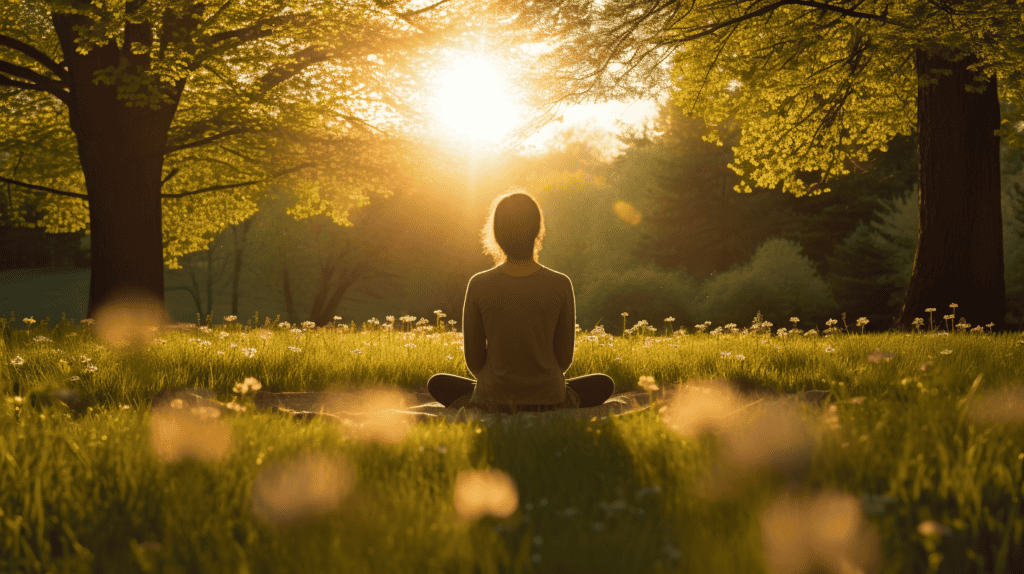Embarking on a spiritual meditation practice can be exciting and daunting for a beginner. But with the proper setup, spiritual meditation can be an enriching part of your daily routine.
So, let’s gain some insight and practical tips for spiritual meditation.
Key Takeaways:
- Set a regular daily meditation practice for 5-20 minutes to start.
- Find a quiet space with minimal distractions when starting to meditate.
- Sit upright with a straight spine or walk mindfully.
- Focus on your breath, a mantra, or an object like a candle.
- When your mind wanders, gently return focus without judgment.
- Start with focused attention practices before open monitoring.
- Use props like cushions or blocks if needed for comfort.
- Apps, books, and meditation groups can provide guidance.
- Be patient with yourself – meditation takes practice.
- Keep notes in a journal to track insights and progress.
- Adjust your practice as needed – posture, time of day, duration.
- Stay motivated by remembering the benefits of meditating.
- With regular practice, you will feel calmer, focused, and self-aware.
Tips on Setting Up Your Meditation Practice
Whether you’re a beginner seeking serenity or a seasoned practitioner deepening your journey, creating a conducive environment, establishing a routine, and adopting an attitude of patience and openness are key.
These tips on setting up your meditation practice are designed to help you craft a tranquil oasis within your daily life where you can retreat to cultivate peace, balance, and mindfulness.
Mindworks explains, “Morning is often considered the best time to start your spiritual practice since the mind is quiet and fresh.”
What is the ideal time of day to meditate? Morning, afternoon, evening?
The ideal time to meditate can vary from person to person. Some find the morning best, as it sets a positive and mindful tone for the day. Others prefer the evening to unwind and process the day’s events. Meditation in the afternoon can also be beneficial for re-centering and combating daytime stress. Ultimately, the best time to meditate is the time that consistently works for you.
Where is the best place to meditate at home? Bedroom, living room, patio?
Finding the right place at home is essential for a successful spiritual meditation practice. Look for a space that is quiet, where you can be undisturbed. This could be a corner of your bedroom, a spot in your living room, or even outside on a patio if the weather and environment permit.
Ensure that your chosen space feels safe and serene, which may involve setting up a small altar or surrounding yourself with items that induce a sense of peace.
What is the proper posture for meditation? Sitting, lying down, walking?
The optimal posture for meditation is one in which you are both comfortable and alert. Most people sit on a chair or cushion, with their back straight and hands resting gently on their laps. If sitting is uncomfortable, lying down is also acceptable, although it’s easier to doze off in this position.
Walking meditation is another excellent option, especially for those with trouble sitting still. It involves walking slowly and mindfully, paying close attention to the movement of your body.
How long should a beginner meditate each day starting? 5 mins, 10 mins, 30 mins?
When just starting, it’s best to start with short sessions of about 5 to 10 minutes. This makes the practice manageable and helps form the habit without becoming overwhelming. As you become more comfortable with meditation, you can increase the duration gradually. Aiming for 30 minutes of daily practice can be an excellent long-term goal, but remember to pace yourself according to your comfort level.
Tips on Managing Your Mind While Meditating
Effective management of the mind is at the core of any meditation practice. Here are some strategies to help beginners cope with common issues.
What should you do when your mind wanders during meditation? Gently return focus, judge yourself, and push the thoughts away.
It’s natural for the mind to wander during meditation. When this happens, the key is gently returning focus to your meditation object—your breath, a mantra, or something else. It’s important not to judge yourself or become frustrated. Acknowledge that your mind has wandered and bring your attention back naturally and organically.
How can you stay motivated if meditation feels challenging at first? Remind yourself of the benefits, join a community, and read books.
To maintain motivation, regularly remind yourself of the benefits of meditation, which can range from improved mental clarity to a sense of inner peace. Joining a local or online community can provide you with support and encouragement. Reading books on the subject can provide guidance, inspiration, and a deeper understanding of the practice.
Here are some books to help on your meditation journey:
| Book Title | Author’s Name (with intended anchor text) |
|---|---|
| “Wherever You Go, There You Are” | Jon Kabat-Zinn |
| “The Miracle of Mindfulness” | Thich Nhat Hanh |
| “Mindfulness in Plain English” | Bhante Henepola Gunaratana |
| “The Mind Illuminated” | Culadasa (John Yates) |
| “10% Happier” | Dan Harris |
| “Real Happiness: The Power of Meditation” | Sharon Salzberg |
| “Meditation for Beginners” | Jack Kornfield |
| “The Headspace Guide to Meditation and Mindfulness” | Andy Puddicombe |
| “Radical Acceptance” | Tara Brach |
| “The Art of Living: Vipassana Meditation” | William Hart |
What is a helpful mindset to have when thoughts arise during meditation? Let them pass, engage with them, ignore them?

When thoughts arise during meditation, imagine them as clouds passing through the sky. It’s helpful to maintain a mindset of detachment, observing them without engagement and letting them pass. Engaging with or intentionally ignoring thoughts can create resistance, often making them more persistent. Instead, acknowledge their presence and let them float by without attaching any significance to them.
Should you suppress thoughts or let them flow during meditation? Let them flow, suppress them, dwell on them?
In spiritual meditation, the aim is not to suppress thoughts but to let them flow without getting caught up in them. Suppressing thoughts can lead to tension and frustration, whereas allowing them to come and go freely can foster a sense of mental ease. Observing thoughts as a witness rather than an active participant encourages calm awareness.
Using Tools to Meditate
There are many tools that you can use to enhance your meditation practice. Whether tangible or conceptual, these tools can help beginners focus and deepen their spiritual experiences.
What are some useful objects to focus on during meditation? Candle, mantra, breathing, visualization?
Whether you choose a candle, a mantra, breathing, or visualization, selecting an object to focus on helps concentrate the mind and steer it away from distractions. A candle flame offers a steady visual anchor, a mantra gives a rhythmic auditory focus, breathing connects you with the rhythm of life, and visualization ignites the creative aspects of the mind, providing insight and calm.
- Breathing: Siyli.org suggests that focusing your attention on your breath is perhaps the most common type of meditation, where you bring your attention back to the breath whenever your mind wanders.
- Candle Flame: According to Meditationpsyche.com, in Trataka meditation, the practitioner keeps their eyes open and focuses on a physical object, most commonly a candle flame, which can be helpful for those who can’t concentrate with their eyes closed.
- Mantra or Image of Buddha: Psychology Today mentions that the focus style of meditation includes any approach that requires you to direct your attention to a single target, such as a breath, mantra, or image of Buddha while minimizing other thoughts.
Can music be helpful during meditation? Why or why not?
Music can be a powerful aid in setting the tone for a meditation session. It can help calm the mind and create an environment conducive to relaxation and focus. However, choosing music without lyrics and with a calm and steady rhythm that won’t distract you is essential. Ultimately, whether or not to use music is a personal choice based on what best helps you enter a meditative state.
Is meditating in a group or alone better for beginners? What are the pros and cons of each?

Group meditation can provide a sense of community and shared energy to encourage beginners. It can also provide structure and regularity to the practice. However, some may find a group setting distracting or intimidating. Meditating alone offers flexibility and privacy, allowing you to go at your own pace and customize your practice. Beginners should try both and see which resonates more with their needs.
What are mala beads used for in meditation? Counting breaths, mantras, pacing?
Mala beads are traditional tools for keeping count during meditation, particularly when repeating mantras. Each bead represents a count, helping the meditator to stay focused on their practice without worrying about keeping count in their head. Malas typically contain 108 beads, a harmonious number in many spiritual traditions, suggesting the completeness of the meditation cycle. They can also help pace the breaths if one focuses on breathing meditation.
Troubleshooting Problems While Meditating
Even with the best intentions and preparations, meditation can sometimes present challenges. Here’s some advice on how to navigate common problems.
What should you do if you frequently fall asleep during meditation? Adjust posture, meditate with eyes open, avoid meditating lying down?
Falling asleep can be a common issue, especially if you’re meditating in a lying position or particularly tired. To combat sleepiness, try sitting upright, which encourages alertness. Meditating with your eyes slightly open can also help. Choose a time when you’re less likely to doze off, such as after a light walk or shower.
Why might someone experience anxiety doing deep spiritual meditation? Going too fast, lack of grounding, suppressed emotions rising?

Experiencing anxiety during deep spiritual meditation could be due to several factors, such as going too fast in your practice, a lack of grounding, or suppressed emotions coming to the surface. It’s essential to approach meditation gently, allow ample time for grounding practices like mindful walking or yoga, and be prepared to face and process the emotions and thoughts that may arise.
If you experience disturbing thoughts during meditation, what can help? Speaking with a teacher, discontinuing practice for a while, chanting?
Disturbing thoughts can be unsettling, but they are a natural part of the cleansing process that spiritual meditation often incites. Speaking with an experienced meditation teacher who can guide you is advisable. You may also find it helpful to discontinue the specific technique that brings up these thoughts for a while and instead focus on grounding practices or chanting, which can redirect the mind to a more peaceful state.
What can you do if you struggle with physical discomfort while meditating? Change positions, try a walking meditation, use props?
Physical discomfort during meditation is not uncommon, especially when you’re new to the practice. Feel free to change positions to find what’s most comfortable for you. Cushions, chairs, or meditation benches can provide additional support. If sitting still is the main issue, try walking meditation—this form of meditation can be just as effective and may relieve any discomfort associated with sitting.
Variations to Explore while Meditating
As your meditation practice matures, you’ll likely feel ready to explore different variations and deepen your experience. Here are some options to consider.
What kinds of guided meditations are helpful for beginners? Visualization, body scans, breathwork?
For beginners, guided meditations that focus on visualization, body scans, or breathwork can be beneficial. These techniques provide structure and easy-to-follow guidance, which can help anchor the mind and prevent it from wandering. Visualization fosters imagination and relaxation, body scans promote awareness and release of tension, and breathwork helps connect with life’s rhythm.
What are the differences between focused attention vs open-monitoring meditation?
Focused attention meditation involves concentrating on a single reference point, like the breath or a mantra. This form hones concentration and provides a straightforward way to notice when your mind has wandered.
On the other hand, open-monitoring meditation is about observing all aspects of your experience without attachment. This includes awareness of thoughts, feelings, sensations, and sounds, watching them rise and fall in the mind’s landscape. Each type trains the brain differently and serves different purposes in your meditation toolkit.
What are some examples of mantras to repeat in mantra meditation?

In mantra meditation, you repeat a word or phrase with spiritual significance. Some traditional mantras include “Om” (the sound of the universe), “So-ham” (I am that), or “Lokah Samastah Sukhino Bhavantu” (may all beings everywhere be happy and free). However, you can also use any phrase that resonates with you and aligns with your intentions.
What are the purposes of yoga and tai chi as forms of meditation?
Yoga and tai chi are movement-based practices that can also function as forms of meditation. They help cultivate mindfulness through fluid motions, encouraging a meditative state while enhancing physical strength and flexibility. These practices focus on aligning movement and breath, fostering a deep connection between the body and mind.
Tips on Making Progress
As you commit to your meditation practice, you’ll naturally wonder about your progress and how to cultivate your growth further. Here are some pointers for staying on track.
How soon can a beginner expect to see benefits from regular meditation? Days, weeks, months?
The benefits of meditation can manifest quickly or over time; some people notice changes within a few days or weeks of consistent practice, while for others, it might take months. The key is regularity and patience. Even small, subtle shifts in your awareness or stress levels are signs that meditation works.
What signs indicate you are making progress in your meditation practice?
Progress in meditation often comes in the form of greater emotional regulation, a calm demeanor, increased self-awareness, and a more profound sense of spiritual connectedness. Other signs include being able to meditate for more extended periods and finding it more accessible to return to focus when the mind wanders.
How can keeping a meditation journal help your practice?
Maintaining a journal can tremendously enhance your meditation practice. After each session, jot down your experiences, thoughts, and feelings. Over time, you’ll be able to track your progress, notice patterns, and gain insights into your inner life. This practice can help deepen your understanding and commitment to meditation.
When might it be beneficial to attend a meditation retreat?
A meditation retreat can be incredibly beneficial when you’re looking to deepen your practice, seek guidance from experienced teachers, or need to reset your mental state. Retreats offer an immersive experience away from daily distractions, often leading to profound insights and spiritual growth.
Conclusion on Practical Tips for Spiritual Meditation
As we conclude this segment, we’ve explored the practical aspects of setting up a meditation practice for beginners, from the best spiritual meditation techniques for beginners to troubleshooting common issues. We’ve also touched upon ways to deepen and sustain your practice. Remember, spiritual meditation is about connecting with your innermost self and the greater universe. It is a vehicle for mindfulness, spiritual awakening, and ultimate peace.
As you continue to meditate, be kind to yourself. Some days will be easier than others, but each moment spent in meditation contributes to your spiritual journey. May your practice be a guiding light toward spiritual enlightenment. And remember, the true power of meditation reveals itself in the quiet persistence of your practice. Listen to your inner guide, permit yourself to grow naturally, and enjoy the benefits that spiritual meditation will unfurl within your life.
This guide should help you get started with practical tips and shared wisdom from a meditation teacher who has walked the path. May you find solace, joy, and profound insights while practicing spiritual meditation. Namaste.
FAQ on Meditation for Beginners
Q: How can I start my spiritual meditation practice as a beginner?
A: Starting a spiritual meditation practice, especially meditation for beginners, is easier than it seems. You could start by dedicating a specific time of day to your practice. Find a place where you feel calm and relaxed. Sit in a comfortable position, close your eyes, and take a couple of deep breaths. As you breathe in and out, please focus on the feeling of your breath as it goes in and out. If your mind wanders, gently bring it back to your breathing. With practice, you will start to feel the spiritual power that meditation offers and clear your mind.
Q: What is a type of spiritual meditation technique that can enhance my spiritual awareness?
A: Mindfulness meditation is a type of spiritual meditation technique that immensely enhances your spiritual awareness. It’s all about focusing on the present moment without judgment. This encourages a deep connection between your body, thoughts, and the world around you, leading to an awakened state of spiritual consciousness.
Q: How does spiritual meditation help in wellbeing?
A: Spiritual meditation helps in well-being in several ways. It allows you to delve into a deep understanding of your existence, helps you find your inner peace, and builds a profound connection with your surroundings. The many benefits of spiritual meditation include enhanced emotional health, increased focus, reduced stress and anxiety, improved sleep patterns, and enhanced spiritual power, making you realize the beauty of the present moment.
Q: Can I learn more about spiritual meditation? What resources are available?
A: Absolutely! There are numerous resources where you can learn about spiritual meditation more comprehensively. These include online tutorials, meditation guides, books, courses, and guided spiritual meditation sessions by renowned spiritual teachers.
Q: What is the best spiritual meditation for mindfulness?
A: Mindfulness meditation is often considered the best spiritual meditation for cultivating mindfulness. It requires focusing on your breath, thoughts, feelings, and sensations without judgment. It involves training your mind to stay focused on the present moment, ultimately enhancing your capacity for spiritual awakening.
Q: How does visualization meditation contribute to spiritual meditation practice?
A: Visualization meditation is a powerful spiritual meditation technique that contributes to your overall spiritual practice. It involves visualizing images, experiences, or situations you wish to manifest. This method helps evoke feelings of love, joy, compassion, and peacefulness, thereby enhancing your spiritual power and alignment with universal energy.
Q: Can beginners practice Metta meditation? How will this type of spiritual meditation technique benefit me?
A: Yes, Metta meditation, also known as loving-kindness meditation, is a technique that beginners can easily practice. It is a form of spiritual meditation that involves directing positive energy and love towards yourself and others. The benefits of Metta meditation include improved empathy, reduced negative emotions, increased positivity, lowered stress levels, and a heightened sense of spiritual connectivity to the world around you.
Q: What are the notable spiritual meditation benefits?
A: Spiritual meditation benefits are very extensive and profound. They range from improved mental clarity, emotional intelligence, reduced stress and anxiety, to enhanced self-awareness and spiritual power. Additionally, spiritual meditation makes you realize your connection to a larger cosmos and helps you better understand yourself and the world around you, fostering a more profound spiritual awakening.
Q: How can spiritual meditation make me realize my spiritual power?
A: Spiritual meditation enables you to tap into your innate spiritual power by promoting a deep sense of self-awareness and connection to the universe. Through techniques like mindfulness and loving-kindness meditation, spiritual meditation makes you realize your interconnectedness with all living beings, enhancing your understanding of your inner power and potential.
Q: How often should I practice spiritual meditation?
A: The frequency of your spiritual meditation practice depends on your personal preference. However, practicing daily, even for just a few minutes, helps you harness the full benefits of spiritual meditation. Regular practice can lead to a significant spiritual shift, improving mental clarity, embodying peace, and deepening your understanding of your spiritual identity.





Leave a Reply